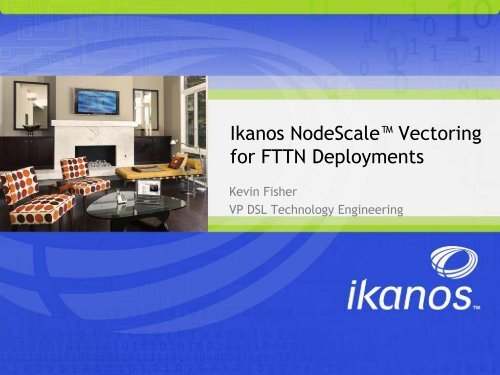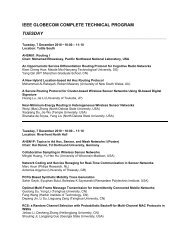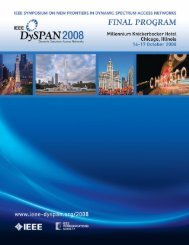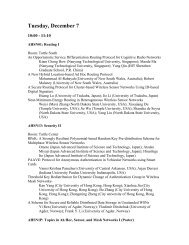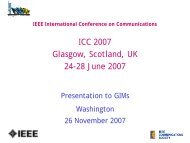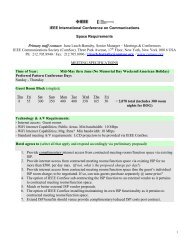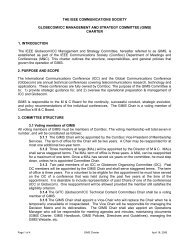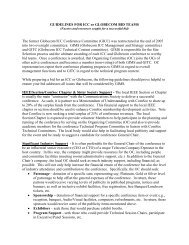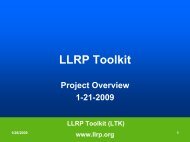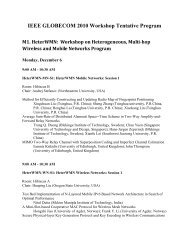Dr. Kevin Fisher, Vice President of DSL Technology Engineering ...
Dr. Kevin Fisher, Vice President of DSL Technology Engineering ...
Dr. Kevin Fisher, Vice President of DSL Technology Engineering ...
Create successful ePaper yourself
Turn your PDF publications into a flip-book with our unique Google optimized e-Paper software.
Ikanos NodeScale Vectoring<br />
for FTTN Deployments<br />
<strong>Kevin</strong> <strong>Fisher</strong><br />
VP <strong>DSL</strong> <strong>Technology</strong> <strong>Engineering</strong>
Outline<br />
Far-end Crosstalk (FEXT) Basics<br />
NodeScale vs. Line-Card Vectoring<br />
Implementation Considerations<br />
Conclusions
FEXT Models<br />
• Conventional Model (worst-case envelope)<br />
• Received FEXT PSD ≈⎜H(f)⎜ 2 k fext f 2 d (N/49) 0.6<br />
f = Freq in Hz,<br />
d = coupled length (meters)<br />
N = number <strong>of</strong> disturbers<br />
• Treats FEXT as a Noise Source<br />
• NIPP-NAI Statistical Model<br />
3<br />
• Beta-distribution, 4x25 Binder Model<br />
• Envelope Model with N=1<br />
• 100x100 Matrix <strong>of</strong> Complex Coupling Gains<br />
• Intra- and Inter- binder Coupling Distributions
FEXT vs. Frequency at 500 meters<br />
4<br />
FEXT<br />
Signal<br />
Background noise floor -<br />
140dBm/Hz<br />
Classical view
Parameters that impact FEXT<br />
• Cable Architecture<br />
5<br />
• Cable type/size, Binder size, Sub-units<br />
• Cable Manufacturing<br />
• Twists/Unit Length, Twist/Insulation Uniformity<br />
• Cable Installation<br />
• Splice points, bend radius, cross box, cable reorg<br />
25<br />
25<br />
25<br />
4x25 pair<br />
25<br />
13<br />
12<br />
12<br />
50-pair<br />
13<br />
5<br />
5<br />
5<br />
50-pair (5 sub-units <strong>of</strong> 5 quads)<br />
5<br />
5
Crosstalk Measurements<br />
6<br />
• 50-pair cable (12-13-12-13): FEXT between binders 1 and 2
Cable Measurements (Quad Cable)<br />
Same<br />
sub-unit<br />
Intersubunit<br />
7<br />
Other<br />
pair <strong>of</strong><br />
quad
Telco Loop Plant<br />
8<br />
Fiber<br />
Copper<br />
<strong>DSL</strong> Access<br />
Central<br />
Office<br />
Cabinet/<br />
Cross Box<br />
Remote<br />
<strong>DSL</strong>AM<br />
Binder assignments lost in cross box
NodeScale vs. Line-Card Vectoring<br />
• NodeScale Vectoring<br />
• Vector (cancel crosstalk) across the entire <strong>DSL</strong>AM<br />
• Share real-time crosstalk signals between line cards<br />
• Dynamically identify/cancel primary disturbers<br />
• <strong>DSL</strong>AM/Chip <strong>Engineering</strong> Challenges<br />
• Line-Card Vectoring<br />
9<br />
• Treat each line card as a separate crosstalk<br />
cancellation domain<br />
• No inter-card coordination required<br />
• Limits gains
17a Downstream, NodeScale Vectored<br />
10<br />
Cancel 47
17a Upstream, NodeScale Vectored<br />
11<br />
Cancel 47
17a Downstream, Line-Card Vectored<br />
12<br />
4 line card system
NodeScale Implementation Issues<br />
• System Diagram<br />
• FEXT Coefficient Memory<br />
• FEXT Coefficient Training Time<br />
13
Vectoring Overview<br />
Coordination via pre- and post- processing <strong>of</strong> signals at <strong>DSL</strong>AM<br />
• Downstream – pre-compensate for FEXT so that signal arrives at CPE<br />
receiver FEXT-free<br />
• Upstream – cancel FEXT in receiver<br />
14<br />
Downstream QAM Data<br />
Symbols<br />
Upstream QAM Data<br />
Symbols<br />
…<br />
…<br />
…<br />
IFFT<br />
DAC/Line driver<br />
FEXT<br />
Precompensator …<br />
…<br />
IFFT DAC/Line driver<br />
FFT<br />
ADC<br />
…<br />
FEXT Postprocessor<br />
IFFT ADC
Memory Constraints<br />
• Example 192 port System<br />
• Memory Size<br />
15<br />
• 4096 tones * 192 ports * 192 ports *4 bytes<br />
• 600MBytes per system<br />
• Memory Bandwidth<br />
• 4kHz symbol rate ⇒ ~2.4TBytes/sec<br />
• Supercomputer memory bandwidth!<br />
• Interpolation, Partial Cancellation<br />
• ~3 MBytes, ~12 Gbytes/sec<br />
• Still high, but plausible
Zoom-In view <strong>of</strong> FEXT Measurement<br />
16
Training Time<br />
• G.Vector Standard-based Training<br />
• Training During Sync Symbols<br />
• 1 sync symbol per 256 data symbols<br />
• 4kHz symbol rate (17a pr<strong>of</strong>ile)<br />
• Orthogonal Training Sequence Length<br />
17<br />
• Related to number <strong>of</strong> ports in systems<br />
• Need 8 or more periods <strong>of</strong> sequence to train<br />
• 256 ports *257 *8*250usec > 2minutes<br />
• Frequency Division Multiplexing<br />
• Reduce Training time by 4-8x
Training Time (cont’d)<br />
18<br />
Classical view
Conclusions<br />
• FEXT varies widely between Telcos and nodes<br />
• Not easy for Telcos to manage binders<br />
• NodeScale Vectoring can provide significant gain<br />
• Line-Card Vectoring may provide little gain due<br />
to operational factors<br />
• Implementation must be carefully considered to<br />
build a practical system<br />
19<br />
Special thanks to my colleagues Nick Sands and Amit Mahadevan<br />
for contributions to this presentation
Thank you.
Line-Card Vectoring<br />
21<br />
• No vectoring communication between line-cards (‘vectoring domains’)<br />
• Each line-card can vector only within its own domain<br />
• Other domains appear as Alien disturbers<br />
• Binder Group Management not possible: Telco not able to group<br />
stronger cross-talkers in the same domain<br />
• Assume random pair/binder to linecard/port assignment<br />
• In practice, <strong>DSL</strong>AM sizes 192-384 ports, with 48-72 ports/linecard <br />
at least 4 linecards/<strong>DSL</strong>AM, possibly 8.<br />
• Assumption: 4 domains, with 80 active users in 100-pair cable (4x25)<br />
• Assign equal number <strong>of</strong> active users to each domain (20), apply full<br />
cancellation to each within domain.


